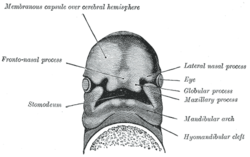| Frontonasal process | |
|---|---|
 Under surface of the head of a human embryo about twenty-nine days old. (Frontonasal process labeled at center left.) | |
| Details | |
| Precursor | Ectoderm |
| Identifiers | |
| TE | process_by_E5.3.0.0.0.0.6 E5.3.0.0.0.0.6 |
| Anatomical terminology | |
The frontonasal process or frontonasal prominence is one of the five swellings that develop to form the face. The frontonasal process is unpaired, and the others are the paired maxillary prominences, and the paired mandibular prominences. During the fourth week of embryonic development, an area of thickened ectoderm develops, on each side of the frontonasal process called the nasal placodes or olfactory placodes, and appear immediately under the forebrain.[1]
By invagination these areas are converted into two nasal pits, which indent the frontonasal prominence and divide it into medial and lateral nasal processes.[2]
- ^ Sadler, T (2006). Langman's Medical Embryology. pp. 280–284. ISBN 9780781790697.
- ^ Larsen, W (2001). Human embryology. pp. 365–368. ISBN 0443065837.